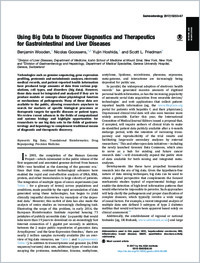Using Big Data to Discover Diagnostics and Therapeutics for Gastrointestinal and Liver Diseases.
- Wooden B Division of Liver Diseases, Department of Medicine, Icahn School of Medicine at Mount Sinai, New York, New York.
- Goossens N Division of Liver Diseases, Department of Medicine, Icahn School of Medicine at Mount Sinai, New York, New York; Division of Gastroenterology and Hepatology, Department of Medical Specialties, Geneva University Hospital, Geneva, Switzerland.
- Hoshida Y Division of Liver Diseases, Department of Medicine, Icahn School of Medicine at Mount Sinai, New York, New York. Electronic address: yujin.hoshida@mssm.edu.
- Friedman SL Division of Liver Diseases, Department of Medicine, Icahn School of Medicine at Mount Sinai, New York, New York.
- 2016-10-25
Published in:
- Gastroenterology. - 2017
Big Data
Drug Repurposing
Precision Medicine
Translational Bioinformatics
Biomarkers
Computational Biology
Data Mining
Drug Discovery
Gastrointestinal Diseases
Humans
Liver Diseases
Molecular Targeted Therapy
English
Technologies such as genome sequencing, gene expression profiling, proteomic and metabolomic analyses, electronic medical records, and patient-reported health information have produced large amounts of data from various populations, cell types, and disorders (big data). However, these data must be integrated and analyzed if they are to produce models or concepts about physiological function or mechanisms of pathogenesis. Many of these data are available to the public, allowing researchers anywhere to search for markers of specific biological processes or therapeutic targets for specific diseases or patient types. We review recent advances in the fields of computational and systems biology and highlight opportunities for researchers to use big data sets in the fields of gastroenterology and hepatology to complement traditional means of diagnostic and therapeutic discovery.
- Language
-
- English
- Open access status
- bronze
- Identifiers
-
- DOI 10.1053/j.gastro.2016.09.065
- PMID 27773806
- Persistent URL
- https://folia.unifr.ch/global/documents/130884
Statistics
Document views: 32
File downloads:
- Full-text: 0
